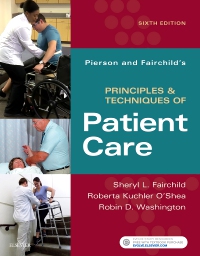
Pierson and Fairchild's Principles & Techniques of Patient Care - Elsevier eBook on VitalSource, 6th Edition
Elsevier eBook on VitalSource

Help your PT and OT students master the basics of rehab patient care with this proven text! Pierson and Fairchild’s Principles & Techniques of Patient Care, 6th Edition not only provides clear "how-to" information on everything from positioning and draping to patient transfers and ambulation activities, but it also includes easy-to-understand rationales that will give your students the "why" behind these proven techniques. This new edition has been thoroughly updated to reflect the most current accepted patient care standards, principles, and techniques. Plus, additional video clips and expanded educator resources will help ensure students walk away with a solid mastery of patient care in the rehabilitation setting.
Newer Edition Available
Pierson and Fairchild's Principles & Techniques of Patient Care - Elsevier eBook on VitalSource
-
- NEW! Additional video clips demonstrate patient transfers, ambulation with aids, and maneuvering a wheelchair.
- Guidelines, principles, procedures, and precautions boxes throughout the text offer additional tips for optimal assessment and management of patients in the rehabilitation setting.
- Video clips on companion Evolve website demonstrate the techniques and procedures described in the text.
- NEW! Video clip table of contents lists over 30 video clips in the front matter of the text. (Do we have this many?)
- NEW! Procedures index lists all of the procedures covered in the text to help students and rehabilitation professionals quickly locate procedure descriptions while working in the clinical setting.
- Content based on the World Health Organization’s ICF model (International Classification of Functioning, Disability, and Health) — the model currently endorsed by the APTA and AOTA — ensures your students are learning from the most current theories and practice guidelines of physical and occupational therapy.
- More than 800 full color photographs clearly demonstrate proper performance of techniques and procedures used in the assessment and management of patients in the rehabilitation setting.
- Procedures boxes with clear written instructions are accompanied by full-color illustrations on performing a variety of proven techniques and patient care tasks such as proper lifting techniques, patient transfers, basic wound care, and assessment of vital signs.
- Insights into the rationales and physiological principles explaining why specific techniques and procedures are used gives students the information they need to develop problem-solving skills in their patient encounters.
- Self-study and problem solving (case study) activities conclude each chapter to help students understand important concepts and improve their decision-making and problem solving skills.
- Content on professionalism and the concept of professional values/ethics reinforce existing guidelines and how to apply those guidelines to patient interactions.
- Online student resources on the companion Evolve website feature video clips and additional activities for students to hone their skills.
- NEW! Expanded online educator resources include updated and expanded PowerPoint lecture slides and test bank questions, as well as recommended answers to self-study and problem solving (case study) activities for students that are found in the print book.
-
- NEW! Procedures index lists all of the procedures covered in the text to help you quickly locate procedure descriptions while working in the clinical setting.
- NEW! Additional video clips demonstrate patient transfers, ambulation with aids, donning and doffing PPE, and maneuvering a wheelchair.
- NEW! Video clip table of contents lists over 30 video clips in the front matter of the text.
-
1. Preparation for Patient Care Activities
2. Approaches to Infection Control
3. Assessment of Vital Signs
4. Body Mechanics
5. Positioning and Draping
6. Basic Exercise: Passive and Active Range of Motion
7. Features and Activities of Wheelchairs
8. Transfer Activities
9. Assistive Devices, Patterns, and Activities
10. Special Equipment and Patient Care Environments
11. Basic Wound Care and Specialized Interventions
12. Incidents and Emergencies
13. Americans with Disabilities Act and Environmental Assessments
Bibliography
Appendixes
Index


 as described in our
as described in our 